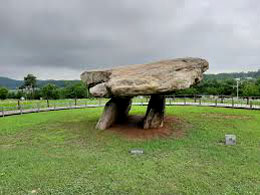Megaliths are considered to be the earliest surviving man-made monuments. Describe in brief some aspects of megalithic age in India. (150 words)
Sakshi Education
By Srirangam Sriram, Sriram's IAS, New Delhi.


Megalithic people struck with the idea of erecting massive stone structures. These monuments are the earliest surviving man-made monuments we know of—are called megaliths.
Megaliths were constructed either as burial sites or commemorative (non-sepulchral) memorials.
Megaliths were constructed either as burial sites or commemorative (non-sepulchral) memorials.
- Burial sites: These megaliths are sites with actual burial remains, such as dolmenoid cists (box-shaped stone burial chambers), cairn circles (stone circles with defined peripheries) and capstones (distinctive mushroom-shaped burial chambers found mainly in Kerala). The urn or the sarcophagus containing the mortal remains was usually made of terracotta.
- Other sites: Non-sepulchral megaliths include memorial sites such as menhirs.
Period: Taken together, these monuments lend these disparate peoples the common traits of what we know as megalithic culture, one which lasted from the Neolithic Stone Age to the early Historical Period (2500 BC to AD 200) across the world. In India, archaeologists trace the majority of the megaliths to the Iron Age (1500 BC to 500 BC), though some sites precede the Iron Age, extending up to 2000 BC.
Region: Megaliths are spread across the Indian subcontinent, though the bulk of them are found in peninsular India, concentrated in the states of Maharashtra (mainly in Vidarbha), Karnataka, Tamil Nadu, Kerala, Andhra Pradesh and Telangana. Even today, a living megalithic culture endures among some tribes such as the Gonds of central India and the Khasis of Meghalaya.
Mode of subsistence: Megalithic people carried out agricultural activity in both the rabi and kharif seasons. A large variety of grains such as rice, wheat, kodo millet, barley lentil, black gram, horse gram, common pea, pigeon pea and Indian jujube have been recovered from habitations.
Concept of afterlife: The very idea of burying the dead along with burial goods indicates strong belief in life after death and possibly rebirth among megalithic people.
 Craft practices: The range of iron artefacts recovered indicate that the megalithic people practiced a wide range of occupations and included carpenters, cobblers, bamboo craftsmen, lapidaries engaged in gemstone work, blacksmiths, coppersmiths and goldsmiths, proof of complex social organization. Beads made of various semi-precious stones and steatite have also been found. Bronze figurines of animals like buffaloes, goats, tigers, elephants and antelopes have been recovered from inside urn burials at the site of Adichanallur in the Tirunelveli district of Tamil Nadu.
Craft practices: The range of iron artefacts recovered indicate that the megalithic people practiced a wide range of occupations and included carpenters, cobblers, bamboo craftsmen, lapidaries engaged in gemstone work, blacksmiths, coppersmiths and goldsmiths, proof of complex social organization. Beads made of various semi-precious stones and steatite have also been found. Bronze figurines of animals like buffaloes, goats, tigers, elephants and antelopes have been recovered from inside urn burials at the site of Adichanallur in the Tirunelveli district of Tamil Nadu.
Region: Megaliths are spread across the Indian subcontinent, though the bulk of them are found in peninsular India, concentrated in the states of Maharashtra (mainly in Vidarbha), Karnataka, Tamil Nadu, Kerala, Andhra Pradesh and Telangana. Even today, a living megalithic culture endures among some tribes such as the Gonds of central India and the Khasis of Meghalaya.
Mode of subsistence: Megalithic people carried out agricultural activity in both the rabi and kharif seasons. A large variety of grains such as rice, wheat, kodo millet, barley lentil, black gram, horse gram, common pea, pigeon pea and Indian jujube have been recovered from habitations.
Concept of afterlife: The very idea of burying the dead along with burial goods indicates strong belief in life after death and possibly rebirth among megalithic people.
 Craft practices: The range of iron artefacts recovered indicate that the megalithic people practiced a wide range of occupations and included carpenters, cobblers, bamboo craftsmen, lapidaries engaged in gemstone work, blacksmiths, coppersmiths and goldsmiths, proof of complex social organization. Beads made of various semi-precious stones and steatite have also been found. Bronze figurines of animals like buffaloes, goats, tigers, elephants and antelopes have been recovered from inside urn burials at the site of Adichanallur in the Tirunelveli district of Tamil Nadu.
Craft practices: The range of iron artefacts recovered indicate that the megalithic people practiced a wide range of occupations and included carpenters, cobblers, bamboo craftsmen, lapidaries engaged in gemstone work, blacksmiths, coppersmiths and goldsmiths, proof of complex social organization. Beads made of various semi-precious stones and steatite have also been found. Bronze figurines of animals like buffaloes, goats, tigers, elephants and antelopes have been recovered from inside urn burials at the site of Adichanallur in the Tirunelveli district of Tamil Nadu.Published date : 27 Oct 2020 11:19AM






